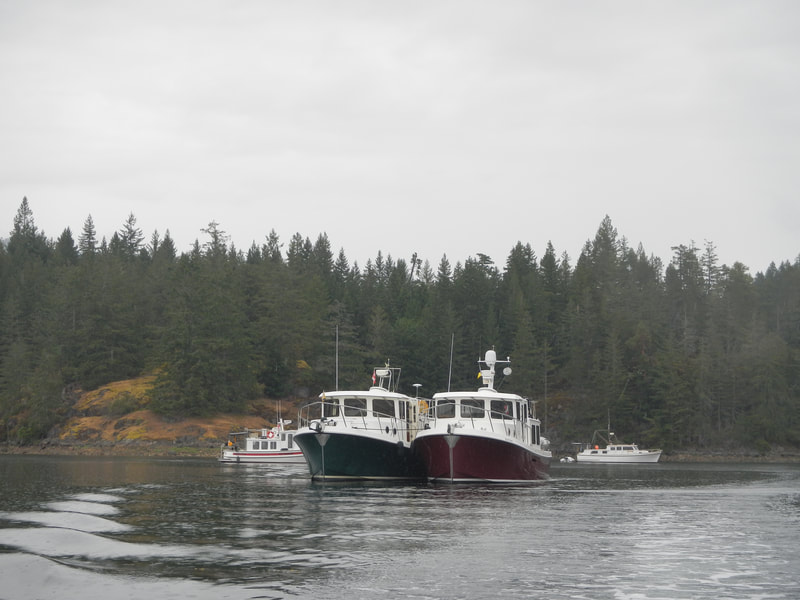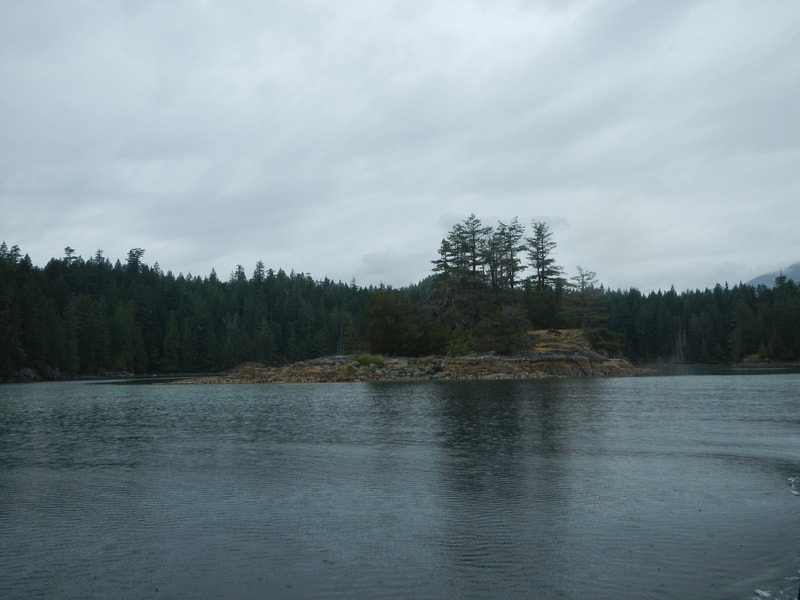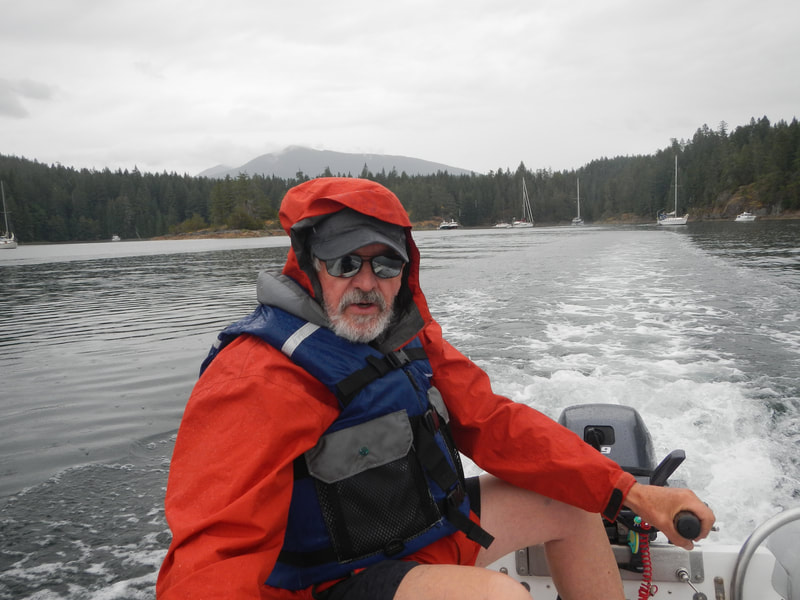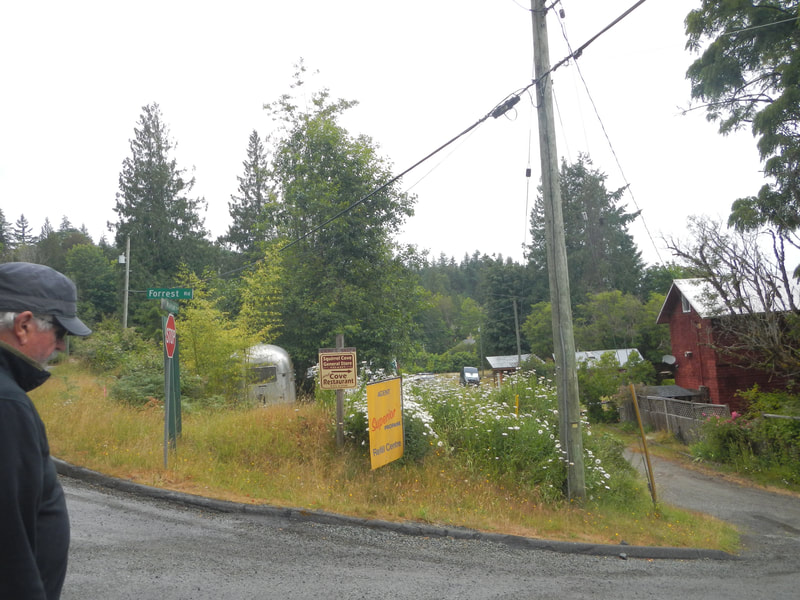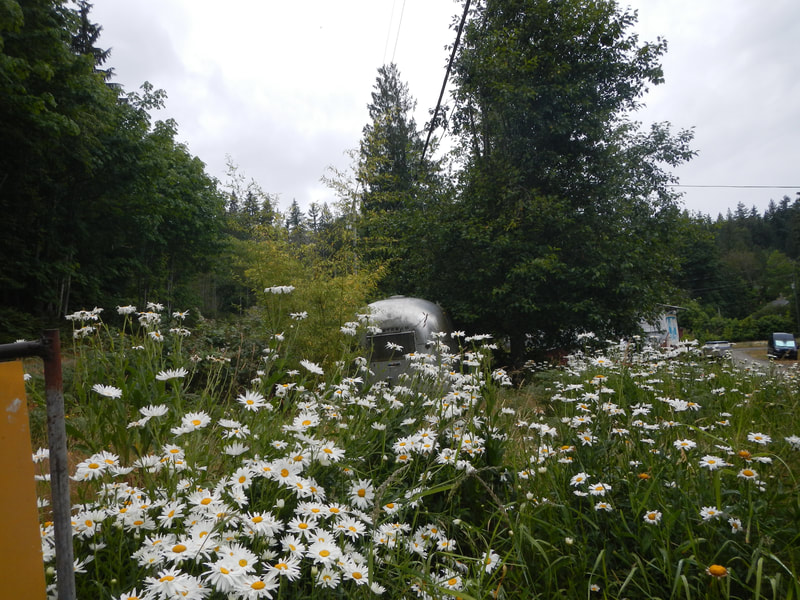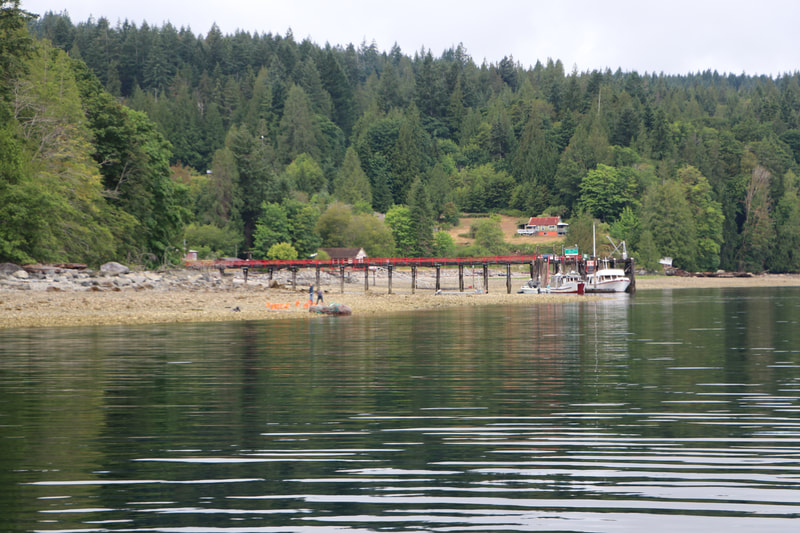|
In 2005 we spent a couple weeks in Desolation Sound with our then-new 25 foot C-Dory. We're just back from a three-week return trip in our new-to-us Nordic Tug. Just like last time, this trip was absolutely blissful. Except for a genuinely minor things: biblical rain, limited and expensive groceries, including $9 expired milk, anchoring mortification, and "holy crap" boating conditions. In other words, the makings of perfect stories. Note: This is a comprehensive (long) post. If you only have a few minutes, start with the Refuge Cove and Toba Wilderness stories. If you're really in a hurry, here are some highlight reels: Note: Use the + and - buttons above to zoom in on this map. You can get a better idea of our destinations. But a lot of the places we went aren't even ON the map! Google-ers must not be boaters. Trip at a glance... Best/Worst Experiences:
Vital statistics:
And now for the report... Prevost Harbor, Stuart Island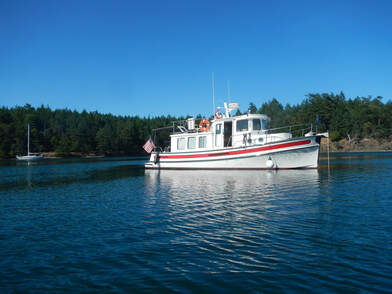 We spent the first night at my favorite place in the San Juans, Prevost Harbor. It's a couple miles from the border making it fairly easy to get into Canada the next day. To make it even easier, we recently got Nexus cards, which simplify going back and forth between the US and Canada. If all goes well, you just need to call the border patrol as you come and go. Coming back to the US they give you a report number and rarely ask you to drop by a Customs Station. When going into Canada, your first stop has to be at a dock monitored by the Canadian border patrol whether they want to see you or not. Some, such as Bedwell Harbor, have permanent stations. Others, such as Port Browning, don't. Generally they won't send anyone over to check you out. You just have to tell the CBP when you'll arrive, get there on time, and wait as long as they ask you to. Then you're free to go. Naturally, we went to Port Browning. Port Browning, North Pender IslandBut first, a word about booze The border patrol didn't meet us on the dock at Port Browning, so we didn't get to show off our strict adherence to import restrictions. For groceries, we threw up our hands trying to decipher the rules and just buy whatever we needed in Canada. But alcohol is different. Canadian prices are eye-watering. Example: A six pack of Michelob Ultra was around $13 in BC. A case of 24 is about $25 in the US. Yep, 4 times as much. I did find one bargain in BC: The house brand, Canadian Club, (CC in Canada) is about par with our prices. Clearly, financial planning comes in to play here. BYOB optimization quiz: If you liked them all and each of you could take either:
Which brings us back to Port Browning. Not only does Port Browning have a lovely un-manned customs dock it also has good shopping just a short, steep mile up the hill from the marina. Driftwood Centre is a charming little shopping village featuring the boater's four essentials: grocery store, liquor store, bakery, and pharmacy. I imagine marine parts could be useful too, but happily we didn't need any. The grocery store is well-stocked. Plus, if you buy more than $25 worth of groceries, they'll give you a ride back to the marina. Just make sure you've finished all your other shopping before you ask for a ride. I kept one of the store employees waiting for ten minutes, not realizing how long the bakery line would be. (If you go to the bakery, try a Nanaimo Bar. Indescribable.) We'd only come 10 miles for the day, so had planned to just run up to the store then head further north. But we were lucky to run into friends and dock mates Carl Bergen and Linda Page on their boat Mariner. With such good company, we decided to spend the night. They didn't have poutine, which I craved, but the pub dinner was wonderful, followed by a lively round of dice games out on the deck of their beautiful boat. It's always good to know people with much larger boats, cocktails are much more relaxing. Montague Harbor, Galiano IslandWe stopped at Montague Harbor both on our way to and from Desolation Sound. It's large, protected, relatively easy to get into, and offers a lot of fun things to do. We love the immaculate and beautiful Provincial Park (which includes a number of mooring buoys, cash only-take Canadian for this). There is also a small marina with a store (featuring a large book section and hand-scooped ice cream), fuel dock, and a pub. If you're interested in a funkier pub, hop on the raucous Hummingbird Bus and join the thousands of other tourists who've waited a long time for a decent meal soaking in the hippy vibe. We went in 2004 and it's a special memory. I saw people smoking POT for heaven's sake. Different time. On our return trip we met a wonderful couple from Nanaimo who just bought a boat very similar to ours. We had a delightful visit. Plus we were happy to have someone to take our forbidden groceries before we left Canada. (Did you know you can't bring EGGS into the US?) Pender Harbor, BC Sunshine CoastJohn Henry's Marina, Hospital Bay (northbound stop over) Pender Harbor is about halfway up the BC coast between Vancouver and Desolation Sound. It's a huge, busy place with a number of coves, bays, and twisty waterways. Some people have called Pender Harbor the "Venice of the North." Some cite great shopping and restaurants in the various alcoves. We would like to meet those people and have them show us what they saw. Regardless, we stopped there each way on this trip. Heading north, while we knew we weren't in Venice, we still didn't feel comfortable trying to find a safe anchorage. So we stopped at John Henry's, the first marina we came across. It was fine, but nothing special. It sure wasn't worth $1.75 a foot plus $10 for power. Particularly when we saw the "Sewage Outfall" sign right over the top of our dingy. Garden Bay (southbound stop over) By the time we came back through Pender we were feeling better about anchoring (you'll find a long side story about this later on) and opted to drop a hook (maties) in the Garden Bay alcove. It was Canada Day eve and we thought the place would be pandamonious and feature fireworks. It was not and did not. In fact, we didn't even get the thrill of trying to figure out if we were going to swing into another boat because there was plenty of room for everyone. Even the derelicts. By the time we got settled we were hungry. Lo and behold just a few yards away on shore was the Garden Bay Pub. No one (except the Brits, of course) does pubs quite like Canadians. Whether or not you’re a fan of poutine, (I am, Fred’s not) you have to go to at least one pub. Our Port Browning visit was pretty good, but no poutine. As I mentioned we skipped the Hummingbird at Montague on this trip: too lazy to even get on the bus. But this pub was just a short dingy ride away. So, off we went. You know when you go into a restaurant and know it's going to be bad? It started at the front door. Rather than tables and customers in the dining room there were a couple chairs and a few people who appeared to be babysitting some kids. So we went into the large tavern area, which was also empty of customers and badly in need of a good scrub and vacuum. I tried to turn and leave but it was too late, the bartender was handing us a limp photocopied menu and ushering us to a table. The menu had a couple pub-sounding items and no poutine (which I wouldn't dare have tried) because the menu was mostly Chinese food. "Ah, the place is in transition," we thought. So we ordered pot stickers and Chow Mein. Wow. The only good thing about our $24 pile of plain dry noodles and $8 plate of gooey pink pot stickers was they didn't make us sick. And the bottles of Corona were fine. So we dodged a bullet there. Malaspina Straights, Texada IslandHeading north, by the time you get to Pender Harbor you're well on your way to Desolation Sound. Getting antsy, in fact. All we needed to do was traverse the Malaspina Straights. This relatively narrow channel sits between Texada Island and mainland BC. I think straights is a short hand for "desperate straights" which in turn is a synonym for "look out for deadly weather." Following the meager forecast information we could find, we were expecting an average of about 12 knot winds. Which would be plenty. Instead we hit 15-20 knots. Ut oh. Here's the video. We learned three important things:
This was the first time we had water splashing over the bow and roof of this boat. When the waves come close together you basically bang up into and over one, fall down, then bang up into another one. It's a challenge to keep the boat pointed straight ahead. And if you turn sideways, the wind and waves could capsize and sink the boat. So Fred was pretty stressed for about three hours till we got past Texada Island. After that, we had another three hours of slogging away to get to our first stop in Desolation: Prideaux Haven. Where I thought anchoring would be simple. Get ready for the anchoring monologue. Prideaux Haven and Melanie Cove aka Anchoring HellIf you think anchoring is simply a matter of dropping the anchor overboard, this next section is for you. If you wonder what the hell the fuss is about, you can skip down a few pages to "Back to the trip report..." Prideaux Haven was an easy anchorage for the smaller, lighter C-Dory we took in 2005. But the Nordic is bigger and heavier so we're not anchoring experts yet. Think of it this way: while you're much less likely to die if you mess up, the skills for safely anchoring are similar to the skills for safely landing an airplane. You need to know how to precisely handle your craft and think through unforeseeable conditions: all in 3-D. (And I have a hell of a time parallel parking.) So getting the anchor down and secure is a bit of an art. The multi-circumnavigating sailor who wrote the "Ultimate Guide to Anchoring" says: "If you don’t know how to safely anchor your vessel for the conditions expected, you should not leave the dock. Anchoring is the bedrock skill of the cruising sailor." By the way, when you're an old salt you call it, "Dropping a hook" and once you're settled you're "Hanging over my hook." Fred was skilled at anchoring the C-Dory. Now it's more of a two-person job and we're both learning how. Which made it a team sport on this trip. First, finding a safe anchorage is essential. It can't be too deep or shallow, has to be protected from wind and strong currents, and have an anchor-friendly bottom (ideally mud). And it needs to be large enough that you won't swing into other boats or the shore. Surprisingly, in the many, many miles of coastline in the San Juans and BC there are relatively few safe anchorages. And they tend to get crowded. Maintaining spacing is a bit harder than you'd imagine. The ultimate anchoring guide says the ideal distance between you and another boat is "as far as possible." When in doubt, move further. If you think you're too close, you are. If another boat thinks you're too close, you are. Well, so much for simply eyeballing. Once you're firmly anchored, depending on your electronics, you should be able to set an alarm to let you know if your boat is moving. Ideally that won't happen, and especially not at night or when you're not on the boat. In Canada, just knowing how to anchor isn't always enough. To help safely fit more boats into an anchorage, Canadian boaters frequently drop the hook then tie their stern to a rock, tree, or other stationary object on shore, such as the chains the park service has installed on sheer walls in some anchorages. To stern tie, you anchor close to shore, get in your dingy or kayak, drag your line to the shore, wrap it around a rock or tree or string it through an anchor chain, then pull it back to your boat and tie it off so you don't have to go back to shore to untie when you leave. How hard can that be? One hell of a lot harder than you'd guess. If you could just walk over to the shore it would be a cinch. But in real life you have to use a dingy or kayak and physically reach your anchor point. It's rare to just buzz over to the shore, reach out of your dingy and grab something. Generally you'll need to dingy over, scramble out of the dingy without losing either it or your footing, secure the line, then get back in the dingy without disaster. If you take your motorized dingy you'll have enough horse power to pull the line back to the boat. But you risk damaging your dingy or motor on rocks, barnacles, and oysters. If you take a kayak, I learned, it can be a nightmare trying to pull the line back to the boat. So here's what happened. Our first night in Prideaux Haven. We anchored and stern-tied without too much trouble. But then the wind came up and threatened to blow us sideways hard enough to make us drag anchor. Rather than have the stern tie pull us into the rocks, we cut it and just rode on the anchor, hoping it didn't pull off the bottom. It didn't, but we felt the urge to move. The next day we tried anchoring out in the bay a couple times, but couldn't get far enough away from other boats. Finally we gave up and went into a little side bay called Melanie Cove. It didn't get better. We had enough room and anchored just fine. Then we spent at least an hour trying to loop the damn yellow poly line through an anchor chain on the rocks. On our first try the line was too short to double back to the boat, so we pulled anchor, backed up, dropped anchor again and tried again. After he had to fight with the dingy to stern tie the day before, I volunteered to use the kayak to secure the line to shore. Stupidest thing I did on the whole trip. The first part was easy, I paddled over to the wall with the line tied around my ankle while Fred played it out from our snazzy stern reel. But imagine what happened when I ran the line through the bottom link and tried to paddle back to the boat while pulling the line through the chain. Of course I couldn't do it! The line didn't come through the link, it simply pulled me back to the wall. That would have been the time to ask Fred to come pull it back using the dingy with 9.9 horsepower. But no, by now I was invested in success! So after getting pulled back a couple of times I finally fed the line through the bottom link on the chain, re-tied the end of the line around my ankle, then pulled as much line through the link as I could, piling it around me in and over the kayak. I didn't get enough through the first time, so had to paddle back and wad some more line into my lap. Meanwhile, Fred was over by the boat inquiring what the hell the problem was. Rather than shout so everyone in the cove could hear me I gave him some pointed gestures requesting that he stop asking (actually using my index finger this time) and continued my labors. There used to be a long paragraph right here where I described getting back to the boat and why Fred had to use the dingy to push the bow of the boat around while I was pulling in the line. But this has already gone on too long, so I'll spare us all. Obviously it was a fiasco and we looked like idiots. Happy Hour--and watching other people look just as inept--helped. And with that.... Back to the trip report I'm all out of breath from the anchor story, so here are the pictures from Prideaux Haven and Melanie Cove. Both are lovely anchorages. Once you know how to anchor. Refuge CoveAfter the trauma of anchoring the first couple nights we were ready for a dock. And I had the perfect place in mind. Refuge Cove is a co-op started back in the 70's. Except for places to hike, has everything I enjoy when we touch down at a marina: a funky hippy vibe with genuinely old buildings, cheap moorage ($1/foot) (pay in store or on honor system) and friendly, hard-working people including young, enthusiastic summer help. Here's a quick video tour. The store has a (relatively) good selection of groceries, most at pretty reasonable prices. If you hear that Squirrel Cove has comparable groceries, we found that to be far from the case. There is also a bakery/café and a liquor store. The manager, Lucy will help you choose the best beer for your taste. Howe Sound Lager for me. Lastly, there are showers, a laundry, fuel dock, and a used book store (honor system). And there's a plentiful supply of good drinking water, which is rare in this area. On your way out, you can even pay Dave the garbage guy $1 a pound to take your trash. (Nearly all remote marinas charge to take your trash, roughly $2/bag and up.) See? You could live there. In fact, one of the things I love about Refuge Cove is that people do live here. Many are only stay for the summer, but a handful are full-timers. As you watch the marina you see residents come and go, some clearly from work and others from nearby homes. The variety of watercraft they use range from high-powered jet skis and motor boats to aluminum landing craft and one fellow who putters around on a party float powered by a 9 horse outboard. So yeah, you could live there. If you're OK with housing that's returning to nature and only having electricity when the town generator is running: between 8AM and 6PM. If you'd rather just experience the lifestyle for a day or two simply tie up to the dock and let the folks in the store know you're staying. If they're not around, you can drop your fees into the honor system box. Beyond the dollar a foot you can get power for your boat for $4 a day, 110 service only (take an adapter) and only while the generator is running. They really do turn the power off at night. Imagine. It's wild to see the whole place go dark after 6PM. (Be sure to get your laundry dry before then.) When the lights on shore went out, I felt like I'd really stepped back to settler days. Of course, we kept the lights on in the boat. 3 Fathoms Cove and Unwin Lake, Desolation SoundThis was by far the most delightful anchorage of our trip. Especially the first 90 minutes. It's so small that when we (easily) anchored right in the middle we thought, "Alone at last!" Then, another boat came in and we needed to move to give him room. This is where the distance that a boat swings on anchor came into play. If you wonder what I mean and skipped the part about anchoring above, this would be the time to read it. A couple yachts and a large sailboat poked their bows into the bay but backed out when they saw us. I was surprised to see them, as the entrance to the cove is only 3 feet deep at low tide. On the other side of the cove an oyster bed on a narrow strip of land exposed at low tide. At high tide you could dingy between our cove and the bigger bay. One of us found the oysters tempting, but we didn't have a license. And in my case, an appetite for slimy seafood. The weather was perfect so we dingy'd over to Unwin Lake. Fred enticed me by saying "Let's go for a swim." I love swimming in lakes but especially love it when we go swimming together. So I hopped in the dingy and off we went. It was a couple miles through the bay, which is a pretty long dingy ride for us. The lake is part of a small park that caters to kayakers. We passed several tents and piles of camp gear on our way to the sun-warmed swimming rocks on the north side of the lake. When I saw how many 20-somethings were on the rocks I took the south fork in the trail. No way was I going to prance around in a swim suit in that crowd. The trail led further into the cool, dark woods. We came to an adorable beach complete with a rowboat on the shore. Off came the shirt and shorts (swim suit underneath) and in I went. Fred kept watch on shore. Huh? It was too cool in the woods to entice him into the cold water. While I was swimming I saw a dragonfly with zebra-striped wings. Of course I didn't have a camera, but I found a picture on Flickr (thanks Desirae). Which brings us to.... Another teachable moment When we got back from the lake our dingy was high and dry on the beach. We'd anchored it off shore, but the tide went out further and faster than we'd anticipated. We had a hell of a time dragging it back into the water over sharp rocks and oyster shells. People offered to help us but we said, "Oh no, we need to learn to do this by ourselves." (And now I know why people don't put fancy boat name graphics--like ours--on the bottom of their dingy's. It's got some serious scratches and we just had it done.) After we got the boat in the water the outboard wouldn't start. People also offered to help with that. By now their looks had turned from pitying to concerned. You could see them thinking, "Should we let these people head out on their own?" In fact, one guy (about our age for heaven's sake) offered to take us back to our boat. "No, no, no" we said, "we'll be fine". And we were, eventually the engine started and we putted back to the mother ship with a few more lessons for the log:
Toba Wilderness, Discovery IslandsToba WildernessThere's every other BC marina, and then there's Toba Wilderness. You won't find groceries, liquor, bakery, fuel, or laundry. But you will find sturdy docks, free hot showers, free low-speed WiFi, ample fresh water, daily trash drop-off, and a Welcome House covered lounge area that makes happy hour virtually mandatory. I like it there so much that although we came planning to stay one night we ended up staying for four. One reason we stayed longer than planned was to allow time to tour the Toba Inlet running east from the marina. It's about a 20-mile round trip to see the major sites, and for us that's at least a four hour cruise. Sitting around the Welcome House we met Michael Short and his wife Barbara. They're a wonderful couple. Lucky us! He turns out to be a professional outdoors photographer. Not only did he give me lots of helpful photography tips, he made this awe inspiring drone video for us. I also made a less impressive video of the marina, a bear, and series of waterfalls. The Toba Wilderness backstory We were here in 2005 and it looked much, much different. Back then it was called Toba Wildernest and fit that cozy funky name. (It has since been "rebranded" Toba Wilderness.) The owner had just bought it and was catching up on a lot of postponed maintenance. We've seen this story before at Lagoon Cove in the Broughtons. A couple goes deep into the wilderness with a vision for a beautiful marina and faith in their ability to bring it to life. They work their butts off to build a magical place while grappling with weather, unforeseeable disasters, and unpredictable income. Sometime after they've finally got it up and running the husband dies. Then the wife can't keep the place up by herself and has to sell. Yes, it's horrible to hear. In this case, the couple bought the land in the 90's and created a rustic retreat complete with a couple cabins, a hot tub by the water, and an ambitious hydroelectric plant using a waterfall high above the marina. (I climbed up there, it really is high!) Kyle came across the marina on a fishing trip and saw the widow's hand-painted For Sale. He'd never thought of running a marina, let alone one in the back of beyond. But he fell in love with the place and couldn't get the idea out of his mind. So he bought it in 2004 and has been working on it every since. Back in 2005, I really couldn't see how he could make it, but he did. How? "Sheer stubbornness," he says. All this beauty and modern services don't come cheap. At $3 a foot, that's more like Roche Harbor prices than Desolation Sound. But we thought it was worth it (enough to stay more than the one night we'd planned) and so did the majority of the other guests we talked to. We're looking forward to going back in a few years. Squirrel CoveWe love Refuge Cove but we heard there was a well-stocked grocery across the channel in Squirrel Cove--which also has a huge protected anchorage--so we were eager to check it out. Sure enough, anchoring was simple. Everything else was beyond disappointing. No one was at fault for the weather. Oddly, when it rained heavily at Refuge Cove I thought it was cozy. When it rained buckets at Squirrel Cove it became oppressive. As the tide came in and the rain kept coming, my brain started perceiving the rising tide as a flood overtaking the banks of the cove. An amusing yet unsettling optical illusion. Undeterred by the rain, groceries called so we put on our rain gear and took the dingy a mile or so down the channel to the Squirrel Cove store. Woah. The dock was run down and populated with boats that looked like they shouldn't be floating at all. But I was still excited at the prospect of finding more good groceries as we hiked up to the store. The place looked a little, rustic, but it wasn't till we walked in that we discovered it was more than rustic, it was decrepit. The store was dusty and tired looking. The drug store section had a random collection of old baby food with faded labels and a couple random pills and ointments. It appeared not to have been restocked for years. Same for the gift shop in the back. The general food shelves were OK. But overall, the place was depressing. A surly woman behind the counter ignored us until I came up to buy the milk we'd come for. The milk was $9 so I thought I'd pay with an American $20 and get some Canadian change. I asked about the exchange rate should I choose to pay with US cash. "I have no idea until I ring it up," she snapped, so I used a credit card. When asked where the bathroom was, she nodded "around back." That turned out to be a hike to a porta-potty perched on the porch of the laundry facility. The porch also featured a sketchy looking fellow and that finished my idea of peeing before heading back to the boat. On the way back I noticed the expiration date on the milk. Two days ago. Perfect! NanaimoI am dangerously fond of the cookies named after this town on Vancouver Island. And Fred keeps telling me how much fun it is to go to the park on Newcastle Island, which even has a dingy pub. So, I was DYING to go to Nanaimo. Well, the good news we were able to get on a dock with no trouble. The Nanaimo Yacht club offers reciprocal moorage for members of our yacht club (another reason to join). We still kept thinking that Canada Day weekend would be insanely busy, even though we'd seen no signs of celebration in Pender Harbor. Aside from heavy traffic in the channel we were docked in, the only celebration we saw in Nanaimo was a sail boat flying a cascade of Canadian flags and a small festival at a local park that broke up at 3PM. And 3 1/2 fireworks that someone shot off in the marina after dark. Three went up about 10 feet and one just sputtered. It's weird, because when we're out in the San Juans during Canada Day we stumble across a lot of very cheerful (read drunk) boaters. They pack in at Friday Harbor and keep everyone awake way past our 8PM bedtimes. The marina is in an older part of town with few businesses, so we had to walk quite a way to get groceries and look for a pub. There weren't any. What the hell, is this really Canada? The closest we found was a hostel with a bar. When we walked in some grizzled alcoholics slowly turned from a beer-soaked table and gave us a bleery stink eye. We scuttled off to a nearby chain restaurant. We sure didn't find a bakery, so forget about Nanaimo bars. Lastly, we were too lazy to motor through heavy boat traffic to the dingy pub, let alone explore the park. Coming south from Nanaimo means going through the notorious Dodd Narrows. It's a tight channel that is best navigated during slack tide. Which means you have to carefully time your trip and chew your nails as you try to go through without crashing into other boats, be they pleasure craft or commercial traffic. Such as log booms. Generally, when in doubt about clearance people take turns going north and south. We waited an eternity for a tug towing a log boom at no more than 2 knots.
When we finally got a chance to go through, Fred announced "35 foot motor vessel heading southbound." His transmission was immediately followed by a woman announcing "90 foot motor vessel heading northbound." I have video of the transit but have left out the part where I loudly called her some crude names. No, I wasn't on the radio, that would raise concerns with the Coast Guard. From Dodd Narrows it was a routine cruise back through the Canadian Gulf Islands to home. We arrived just in time for the 4th of July, which we spent getting our land legs back contemplating the acres of grass and weeds that we are still trying to get under control. Comments are closed.
|
